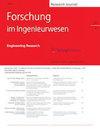通过使用缩短牙齿的重复牙龈来提高电动车的运输效率
IF 1
4区 工程技术
Q2 Engineering
Forschung Im Ingenieurwesen-Engineering Research
Pub Date : 2023-09-13
DOI:10.1007/s10010-023-00707-1
引用次数: 0
摘要
摘要为提高电动汽车齿轮减速器的效率,提出了缩短齿的双交错斜齿轮的应用。交错斜齿轮采用短齿顶和短齿尾设计,齿顶和齿尾之间有相位角。减少功率损失是通过避免在滑动速度较大的齿面之间的接触来实现的,因为在较长的啮合周期中,啮合发生在靠近节圆的区域。效率的计算是基于有限元法的应用,通过两种算法对所得结果进行后处理。第一种方法是基于切向力和滑动速度来计算沿网格循环的功率损失。第二种方法是通过有限元模型的小齿轮和齿轮参考节点处的扭矩和速度来确定输入和输出功率。在所有几何形状的接触齿面之间考虑一个恒定的摩擦系数。对几种两级齿轮传动进行了分析和比较,考虑了标准斜齿轮和相应的短齿、不同齿宽模数比和不同螺旋角的双交错斜齿轮。结果表明,在比较的几何形状中,效率提高了约1.8个百分点。本文章由计算机程序翻译,如有差异,请以英文原文为准。
Verbesserung der Übertragungseffizienz in Elektrofahrzeugen durch den Einsatz von doppelt versetzten Schrägverzahnungen mit verkürzten Zähnen
Abstract The application of double staggered helical gears with shortened teeth is proposed to increase the efficiency of gear reducers applied in electric vehicles. The staggered helical gears are designed with short addendum and dedendum as well as a phase angle between their two parts. Reduction of power losses is achieved by avoiding contact between tooth surfaces where the sliding velocities are larger, since the meshing occurs in areas close to the pitch circle during a longer period of the cycle of meshing. The calculation of the efficiency is based on the application of the finite element method through two algorithms for post-processing the obtained results. The first one is based on the use of tangential forces and sliding velocities to compute the power losses along the cycle of meshing. The second one is based on the determination of the input and output powers through the torques and velocities at the pinion and gear reference nodes of the finite element model. A constant friction coefficient is being considered between the contacting tooth surfaces for all the geometries. Several two-stage gear transmissions are analyzed and compared, considering standard helical gears and their counterpart double staggered helical gears with shortened teeth, different facewidth-to-module ratios, and different helix angles. The results show an improvement in the efficiency about 1.8 percentile points among the compared geometries.
求助全文
通过发布文献求助,成功后即可免费获取论文全文。
去求助
来源期刊
CiteScore
2.20
自引率
9.10%
发文量
33
审稿时长
>12 weeks
期刊介绍:
This journal is aimed at those who require an interdisciplinary overview of current research in fundamental areas of engineering science as well as outstanding contributions in their own field. It intends to encourage an exchange of ideas between the areas of research and development. Submissions are subject to regular peer review by independent experts. Mainly contributions in German from all disciplines of engineering and technology will be considered for evaluation and publication.

 求助内容:
求助内容: 应助结果提醒方式:
应助结果提醒方式:


